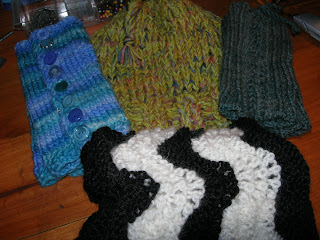
Each year the Australian Sheep and Wool show, held in Bendigo, has a feature breed. This year it is Border Leicester.
For the last few years, the hardworking Woolcraft committee have been able to obtain donations of the particular fleece for people to try and the results have been displayed at the show. The Experimental Spinning group of the HWSG have been one of the recipients. It's an excellent opportunity to try a variety of different fleeces, most of which we wouldn't normally spin.
We did really enjoy the experience and the results have shown us that this fibre is lovely to spin and is not as harsh as you might think from a reasonably strong fleece.

I decided that I would try and spin a coil yarn. This is the latest 'in' novelty yarn and there are a number of teachers focusing on this yarn. At the guild, Janet de Knoop does wonderful yarns and is a lovely teacher who I managed to catch at Harrietville.
The yarn is really a take on the traditional bullion yarn with a couple of modern updates. The single doing the coiling is a slubby yarn and it is this slub part that is coiled. This gives a more rounded look as it changes in thickness. The trick with the slub is not to make it too thick just thicker that the regular part of the yarn. This means there is some nice twist in the slub making it neat. However, with a thicker slub it is a fluffier, lest defined coil. Fun nevertheless!
The other trick is not to use a binder to anchor the coil, as is done with a bullion yarn, but using the core yarn to wrap just before and after the coil, thus anchoring the coil. A nice twist that really allows the coil to stand out.

My version is all handspun from fleece. This makes the slub slightly harder to control and I didn't quite get it right all the time, and, it means that the core yarn is handspun, which I think gives a nicer overall look, but that's without colour!
It also meant spinning in the grease, something I generally don't particularly like. The fun however, is in the washing when all the dirt, swint and lanolin are scoured out. Well most of it and the underlying colour of the fleece is revealed.

Extremely happy!
Not so happy with yesterdays effort with bamboo.

Bamboo is one of those new environmentally friendly fibres. This does depend on the process used in production. There is viscose bamboo, which is made in the same way as rayon with chemicals breaking down the fibre and being extruded to created the fibre. The second is done in the same way as for flax, the major issue being about the use of water. This is more environmentally friendly. Bamboo, itself, is very fast growing and has some excellent properties as a textile, but again, which company doing what. There is little way of knowing what you have.
We decided that as the fibre we were using was short that this had been produced in the more traditional manner, as extrusion tends to create long continuous fibres.
In its raw state it is not pleasant to touch. Very difficult to spin and then difficult to spin evenly. I even managed to have breaks when plying. NOT happy! The final yarn is soft to the touch and is likely to take dye very well.
So, further experiments combining it with other more spinnable fibres are worth exploring. I will also be looking at some of the commercial bamboo yarns to see if I can get any hints.

And, then, what's this rubbish? Well it is. It's the stuff you get when you sort out and flick fleece. There are short cuts, dirty bits, all sorts really. What am I going to do with this? That's what I'm usually asked by beginner spinners. We'll happily throw out all the packaging we do, but wonder about the leftover from cleaning fleece for spinning!
But a challenge has been sitting there for awhile. A spinning friend did collect the same sort of stuff from one of her dyed fleeces, ending up with a bag of colour fluff that she then carded to create a really fluffy fun yarn. I'm going to take it a step further and start with the raw stuff, then dye it and then combine with with something else? A fun challenge!
I'll keep you informed!

















